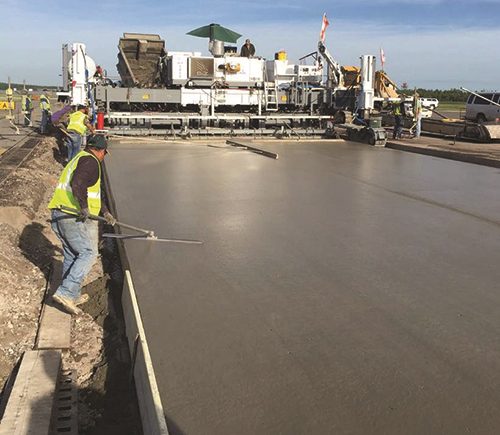Tom Werner, executive director at Duluth International (DLH), is currently celebrating two big milestones: his 20th year working at the northern Minnesota airport and the recent full-length, full-depth reconstruction of its 10,150-foot main runway. As Werner describes it, the $38 million project spanned five calendar years and completely restored the airport’s very backbone.
Tom Werner, executive director at Duluth International (DLH), is currently celebrating two big milestones: his 20th year working at the northern Minnesota airport and the recent full-length, full-depth reconstruction of its 10,150-foot main runway.
As Werner describes it, the $38 million project spanned five calendar years and completely restored the airport’s very backbone.
“I’ve grown up with the organization, and it’s been really exciting to see how it has grown and matured over the years,” he reflects. Looking back, Werner says that his time at the airport has been fun, but there has also been the pervasive challenge of prioritizing various infrastructure projects that ideally would have all been addressed at once.
|
facts&figures Project: Runway Reconstruction Location: Duluth (MN) Int’l Airport Owner: Duluth Airport Authority Carriers: Delta Air Lines; United Airlines; Sun Country Airlines Home to: 148th Fighter Wing, Minnesota National Guard F-16 fighter jets Cost: $38.3 million Funding: $31 million from FAA, $6.5 million from MN Dept. of Transportation; $766,000 from airport authority Design, Engineering, Planning, Construction Admin & Outreach: SEH Construction: PCI Constructors (Phase 1 & 2); Shafer Contracting (Phase 3) Electrical Contractor: Parsons Electric Lighting Improvements: 500 LED lights, 40 miles of electrical cable, in-pavement MALSR threshold bar lights; PAPI lights on west end Lighting Manufacturer: ADB SAFEGATE Lighting Supplier: Carlo Electrical Suppliers Airfield Lighting Control Management System: ADB SAFEGATE (manufacturer & supplier) |
For instance, rehabilitating DLH’s aging, 60-year-old main runway was put on hold when 9/11 shifted the focus to a $70 million terminal improvement project, which was finished in 2013. During that time, ancillary work was performed to preserve the airfield’s existing infrastructure, “but we knew that full-depth reconstruction for some of our primary surfaces was going to need to happen,” he notes.
The airport’s four commercial airlines, a state National Guard installation and other tenants are thankful it did. The three-phase runway reconstruction ultimately provided new pavement and airfield upgrades that will help them serve the area for decades to come.
Out With The Old…
“Our partners understood that with 60-year-old concrete, there wasn’t any intermediate rehab that could fix all the issues,” Werner explains.
So the airport asked SEH, its overall engineering consultant, to develop a comprehensive and long-term solution for Runway 9-27. Kaci Nowicki, an SEH senior airport planner who has worked with DLH since 2015, explains that the rapidly deteriorating pavement was a known issue that became a pressing problem shortly after the terminal work was finished. “They thought they had more time left, but leadership was thrust into a situation they had to address as soon as possible,” says Nowicki.
Fortunately, tenants and airport partners ultimately understood the difficult situation DLH was in as it worked against the clock. When the project scope was confirmed in 2014, planners immediately began devising a way to execute the full runway reconstruction with minimal disruption to tenants and customers. On the commercial side, DLH serves 320,000 annual passengers via two major airlines (Delta and United) and one low-cost carrier (Sun Country Airlines). Daily flights to Chicago and Minneapolis are mainstay routes.
Shawn McMahon, a lead engineer and project manager with SEH, explains that the goal was to make reconstruction work as undisruptive as possible, while also building in upgrades to reduce the airport’s future maintenance expenses.
 To manage such a large project, the team developed a three-phase project that would begin in 2015 and conclude in 2019. “We had to consider the times in which we could do construction, as the window for that in northern Minnesota is short,” McMahon explains. “And it would be next-to-impossible to do almost two miles of concrete in a single year, both logistically and financially.”
To manage such a large project, the team developed a three-phase project that would begin in 2015 and conclude in 2019. “We had to consider the times in which we could do construction, as the window for that in northern Minnesota is short,” McMahon explains. “And it would be next-to-impossible to do almost two miles of concrete in a single year, both logistically and financially.”
The phasing plan was also designed to be sensitive to everyone’s needs and offer a solution that fixed the runway without stopping necessary business altogether, he adds. Mother Nature apparently didn’t get the memo, because she sent an unseasonably early snowstorm near the end of the project.
Although the bad weather was outside anyone’s control, it still delayed construction and caused difficulty for paving contractors, notes Werner. On the flipside, the project also had pleasantly cool days early in the schedule that allowed contractors to tear into the runway and reveal the level of deterioration that existed under the pavement surface. “To know we were fixing that to serve the general public made me happy,” Werner reflects. “And it reinforced that this was the right project to take on.”
In With The New
The project team prioritized the center 6,200 feet of the runway for Phase 1. The western 2,000 feet was reconstructed in Phase 2, and the final 2,000 feet on the eastern end was reconstructed during Phase 3. In total, contractors placed 200,000 square yards of new concrete.
Working with a runway that was originally built to train pilots for World War II, the team lacked accurate as-built drawings. Contractors initially assumed it contained about 12 inches of reinforced concrete, but ultimately found no reinforcement at all—a discovery that helped explain the high degree of deterioration.
“For that reason, we added a major upgrade and reinforced the concrete,” says Werner. “We now have full-strength, 12-inch reinforced concrete.”
 Previous drainage issues for airfield lighting were also resolved with new in-pavement lighting, MALSR threshold bar lights (Medium Intensity Approach Lighting System With Runway Alignment Indicator Lights), and PAPI lights (Precision Approach Path Indicator) on the west end. In all, the airport added 500 LED lights and 40 miles of electrical cable.
Previous drainage issues for airfield lighting were also resolved with new in-pavement lighting, MALSR threshold bar lights (Medium Intensity Approach Lighting System With Runway Alignment Indicator Lights), and PAPI lights (Precision Approach Path Indicator) on the west end. In all, the airport added 500 LED lights and 40 miles of electrical cable.
It also reconfigured the 27 end of the runway to eliminate a “hotspot,” or area that can cause pilot confusion, with a connecting taxiway. Werner reports that the change is working well.
Phasing and work scheduling were particularly vital during the reconstruction.
Taking the main runway offline during Phase 1 essentially closed DLH for aircraft that can’t land on its much shorter 5,700-foot crosswind runway. The airport knew that some large aircraft would be challenged to operate during Phase 1, when work was being completed on the center section of the runway; but this was an unfortunate reality associated with the improvement project.
“We did our best to minimize impact,” says Werner.
Interestingly, the timing for Phase 1 was scheduled around the Guard unit’s extended deployment to southwest Asia in support of the Global War on Terrorism. “We recognized a window of opportunity and knew we could get that critical section reconstructed during the Fighter Wing’s deployment,”
McMahon recalls.
The airlines were sometimes affected—for instance, when weather required them to reduce loads and weight for safe operations while they used crosswind runway during Phase 1 construction.
However, such issues were especially impactful for DLH’s non-airline tenants: the 148th Fighter Wing of the Minnesota Air National Guard, which flies F-16 fighter jets; AAR, the resident aircraft maintenance facility, which serves a customer that flies Airbus 319 and 320 commercial aircraft; and Cirrus Aircraft, which manufactures single-engine piston and jet aircraft and employs more workers than any other airport tenant.
A shortened runway with displaced threshold was used during phases 2 and 3, and the National Guard used temporary arresting gear to help stop aircraft in the case of an emergency and to meet requirements for the temporary 7,000-foot runway arrangement. Without such provisions, the project would have been much more impactful to users, notes McMahon.
“The 148th as well as airline and other users could continue to operate safely and keep flying while construction was happening through use of the displaced threshold,” he adds.

Meeting Challenges Together
After experiencing DLH’s three-phase, multi-year runway project, Werner counsels directors at airports of all sizes to have a solid master plan and 20-year infrastructure vision—one that is financially feasible and provides predictability for all vital stakeholders.
“They need to know what’s coming and when,” he emphasizes. “It eliminates surprises and helps the organization financially plan and sequence a major infrastructure project like this.”
 Nowicki adds that the DLH project team enacted a fast-paced triggering event master plan during Phase 1 to help facilitate the runway geometry issue that would be fixed in Phase 3.
Nowicki adds that the DLH project team enacted a fast-paced triggering event master plan during Phase 1 to help facilitate the runway geometry issue that would be fixed in Phase 3.
“We did a very focused planning study around the airport’s runway and taxiway system,” she says. “For Runway 9-27, we had to perform a cost analysis on the existing infrastructure to justify funding to the FAA because it is quite large. Then, we had to fix two hotspots.”
The team consequently analyzed several alternatives and encouraged stakeholder engagement to work through the process. Ultimately, it developed a plan to relocate the runway end and threshold, remove an in-line taxiway and execute other safety improvements.

Nowicki, who managed the collaboration process, says that focused planning up front yielded more accurate cost estimates, resolved many details before the design process even began, and helped set the stage for construction to finish on schedule.
“I think the airport definitely saw the benefit of that, and actually just started another large master plan this past year,” Nowicki adds.
The airport calls its new program Vision 2040, and Werner considers this a perfect time to engage vested parties on and off the airport in long-term planning. There is no doubt that everyone is enjoying the new pavement—and the safety and reliability it provides, he explains.
“It will be that way for the next generation,” Werner adds. “We’ll certainly do our due diligence in terms of maintenance. But this was a major undertaking, and we’re glad to have it done!”



